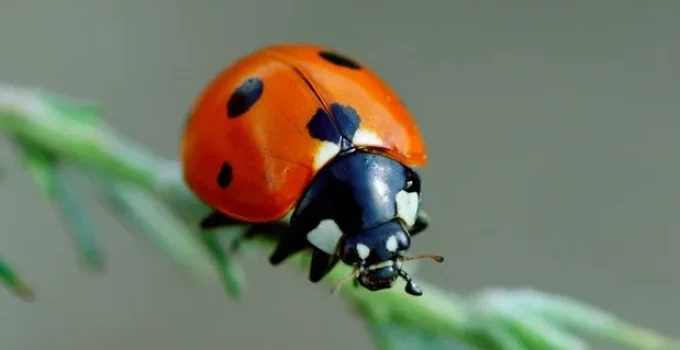What Is the Difference Between Ladybugs and Lady Beetles?
There is no real difference between ladybugs and lady beetles—they are the same insect! The term “ladybug” is more common in North America, while scientists and people in other parts of the world prefer “lady beetle.” Even though they’re called “bugs,” they are actually beetles, not true bugs.
🔎 Dive Deeper
- Why Are They Called Ladybugs or Lady Beetles?
- Are Ladybugs Actually Bugs?
- What Do Lady Beetles Look Like?
- Do All Ladybugs Have Spots?
- Why Are Ladybugs Important?
- 🎯 Final Thoughts
- 📚 References
Why Are They Called Ladybugs or Lady Beetles?
The name “ladybug” goes back hundreds of years. In Europe, farmers prayed to the Virgin Mary to save their crops from pests. When these helpful red beetles showed up and ate the pests, they were called “Our Lady’s beetles.” That name later became “ladybug.”
In modern science:
- The correct name is lady beetle because they belong to the beetle order, Coleoptera.
- “Ladybug” is a nickname mostly used in the United States and Canada.
- In the United Kingdom, people often say “ladybird beetle.”
🧠 Vocabulary Tip: A “true bug” is a different kind of insect in the order Hemiptera, like stink bugs or cicadas. Ladybugs don’t belong in that group!
Are Ladybugs Actually Bugs?
No—they’re not true bugs! Although we often call them “ladybugs,” they are beetles.
Let’s break it down:
| Insect Type | Order | Examples |
|---|---|---|
| True Bugs | Hemiptera | Stink bugs, aphids |
| Beetles | Coleoptera | Lady beetles, fireflies |
Ladybugs (or lady beetles) have hard wing covers called elytra, which protect their wings underneath—this is a clear sign they are beetles, not bugs.
What Do Lady Beetles Look Like?
Most people picture a red, round beetle with black spots, but lady beetles can come in many colors and patterns:
- Red with black spots (common)
- Orange or yellow
- Black with red or yellow spots
- Some even have no spots at all
Lady beetles usually have:
- A small, rounded body
- Six legs
- Two antennae
- Two pairs of wings (one for flying, one for protection)
📊 Fun Fact: There are over 5,000 species of lady beetles in the world, and about 450 species live in North America! [1]
Do All Ladybugs Have Spots?
Not at all! Some lady beetles have many spots, some have none, and others have stripes or blotches instead.
A few examples:
| Species Name | Spot Pattern |
|---|---|
| Seven-spotted lady beetle | 7 black spots on red |
| Asian lady beetle | Variable (0 to 22 spots!) |
| Twice-stabbed lady beetle | 2 red spots on black |
The number of spots does not tell you the insect’s age—it’s just part of its species’ pattern.
Why Are Ladybugs Important?
Lady beetles are helpful insects for gardens, farms, and ecosystems. They eat pests like:
- Aphids
- Mealybugs
- Mites
- Scale insects
This makes them natural pest controllers, reducing the need for chemical pesticides.
🌿 Cool Stat: A single lady beetle can eat up to 5,000 aphids in its lifetime! [2]
Some farmers even buy ladybugs to release in their fields and protect crops.
🎯 Final Thoughts
So, what is the difference between ladybugs and lady beetles? They are two names for the same helpful insect. Even though they’re called “bugs,” they are actually beetles, known for their colorful shells and big appetite for pests. Whether you call them ladybugs, lady beetles, or even ladybirds, one thing’s clear—they are small heroes in gardens and ecosystems around the world.
So the next time you spot one, thank it for protecting plants—and remember, it’s a beetle, not a bug!
📚 References
- University of Kentucky Entomology. “Lady Beetles (Coccinellidae).”
https://entomology.ca.uky.edu/ef105 - Cornell University. “Biological Control with Lady Beetles.”
https://biocontrol.entomology.cornell.edu/predators/ladybeetles.php - National Wildlife Federation. “Ladybugs: Not Really Bugs.”
https://www.nwf.org/Educational-Resources/Wildlife-Guide/Invertebrates/Ladybug - Smithsonian Institution. “Meet the Lady Beetles.”
https://naturalhistory.si.edu
📌Learn More About Insects & Arachnids
- Why Do Crickets Chirp at Night?
- What’s the Life Cycle of a Dragonfly?
- Why Do Ants March in a Line?
- Where Do Butterflies Go In the Winter?
- Why Do Fireflies Glow at Night?
